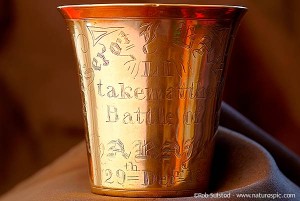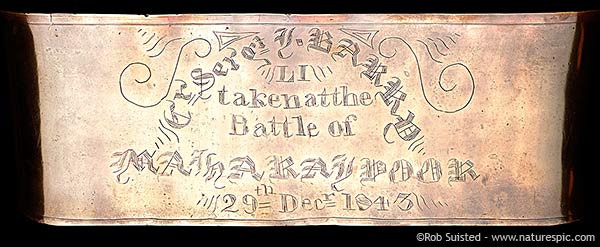I love most the unexpected nature of photography.
Yesterday Garry Glynn contacted me to photograph a family heirloom piece. Other photographers he’d contacted weren’t interested; I assume it being a small paying private job. I had a hunch that there was something more interesting about it, took it on, and luckily I was proved right.
89 year old Garry arrived and delivered to my hand a small simple heavy brass drinking cup similar to many I’d used in India. Nothing special except it had engraving around the outside. It carried a story that I’m still thinking about today; a story of history and horrific human bloodshed.
Turns out Garry’s relative (Col Sgt J. Barry, 39th Dorestshire Regiment) was present at the Battle of Maharajpore, India, on the 29th December 1843. He was lucky to make it. 5000 people did not make it that day! In a nutshell, Central and Northern India had fallen to British forces in 1818, but Marathas in Gwalior saw the failed British campaign in Afghanistan as opportunity to regain independence. The battle ensued. It’s believed that nearly 800 Bristish soldiers and 3-4000 Marathans were killed; an unbelievable slaughter of human beings in one day. The significance of this event for the British is remembered with the Gwalior Star campaign medal.
Garry is passing this family ‘war trophy’ or heirloom down to the next generation and wanted a photo showing all the cup’s text to give to his relatives. My job was to attempt that. Given the circular object with concave face, and the highly reflective nature of the surface, the job wasn’t straightforward. But I love a challenge, and I reckon it could be done.
First up was to prepare the vessel. A good polish brought out a good shine, and a closely held candle flame sooted the surface up nicely, and another shine left a little soot in the engraving. Next was figuring out how to light the face of the vessel with even light. No problems there, get an Elinchrom studio light out and pop on a softbox, but trouble is that you can’t get a camera in there without interrupting the clean lighting. I tried a couple of tilt shift lenses attempting to shoot off the central axis, but this just distorted too much. Then I figured the concave front face would let me lower the softbox and shoot over the top without breaking the clean reflection – great.
Once a nice even light was sorted, next was to carefully rotate the vessel and photograph ovelapping images. Another lens base proved to be the perfect stage.
I ran this through a panorama stitching programme and gave it a clean up. Garry just called around today and seems very happy with the result:
But I’ve been thinking about the cup since: what horrors and good times it has witnessed, and what route it has taken to arrive in my hands? Garry tells me that a number of ‘retired’ seasoned British soldiers were offered land in New Zealand in exchange for being willing to fight in the NZ land wars if necessary. They become known as ‘The Fencibles’, and this is the route in which the cup arrived in NZ.
I also found this gritty, stiff upper lip, description of the battle by Henry Man. It’s a short honest read that gives you an appreciation of how gnastly that day must have been. Please take a moment to read it if you can.
So, all in all, a photo job that paid for itself in not only in dollar terms, but that was also rich in knowledge, experience, and technical challenge.

















